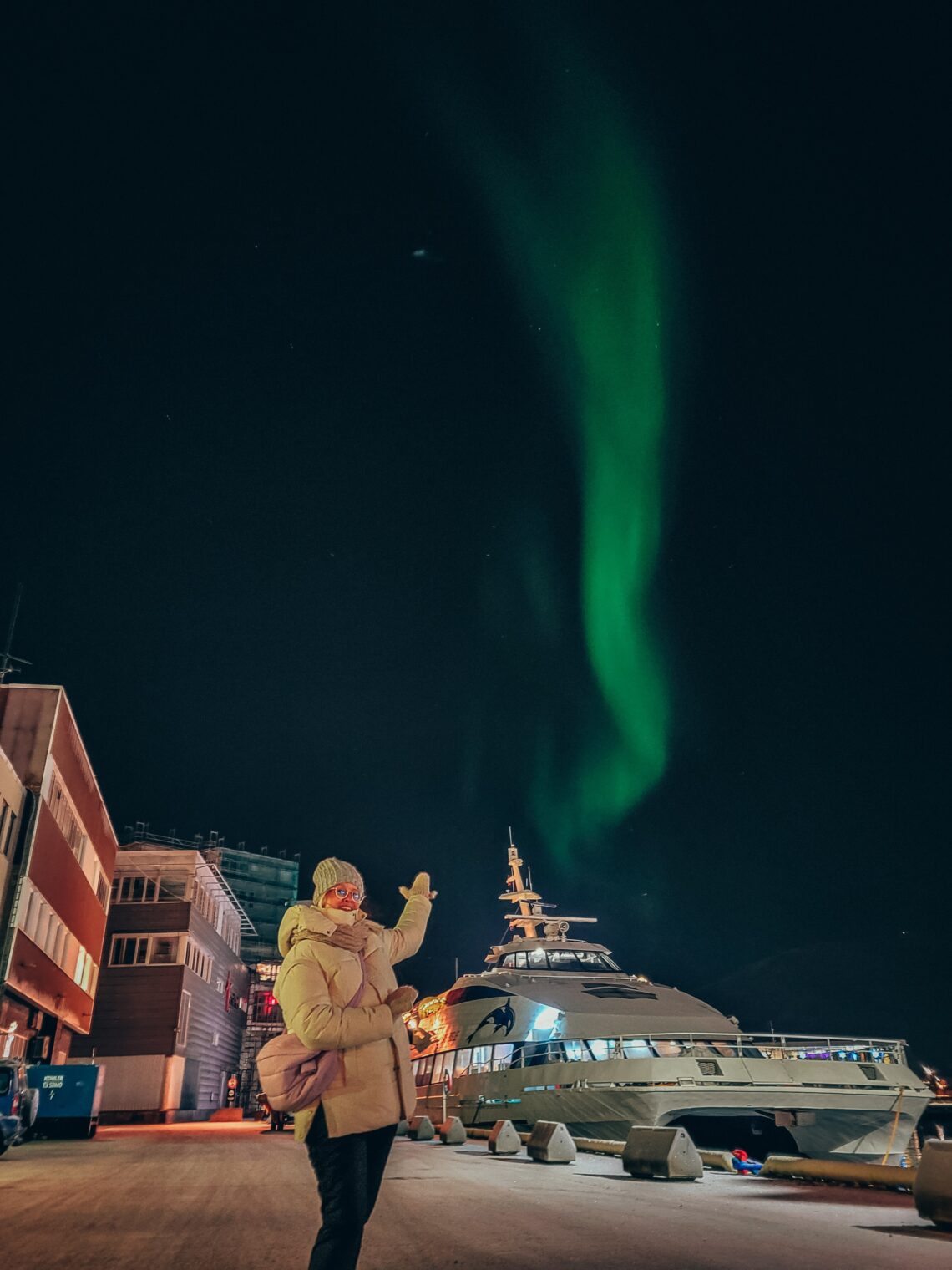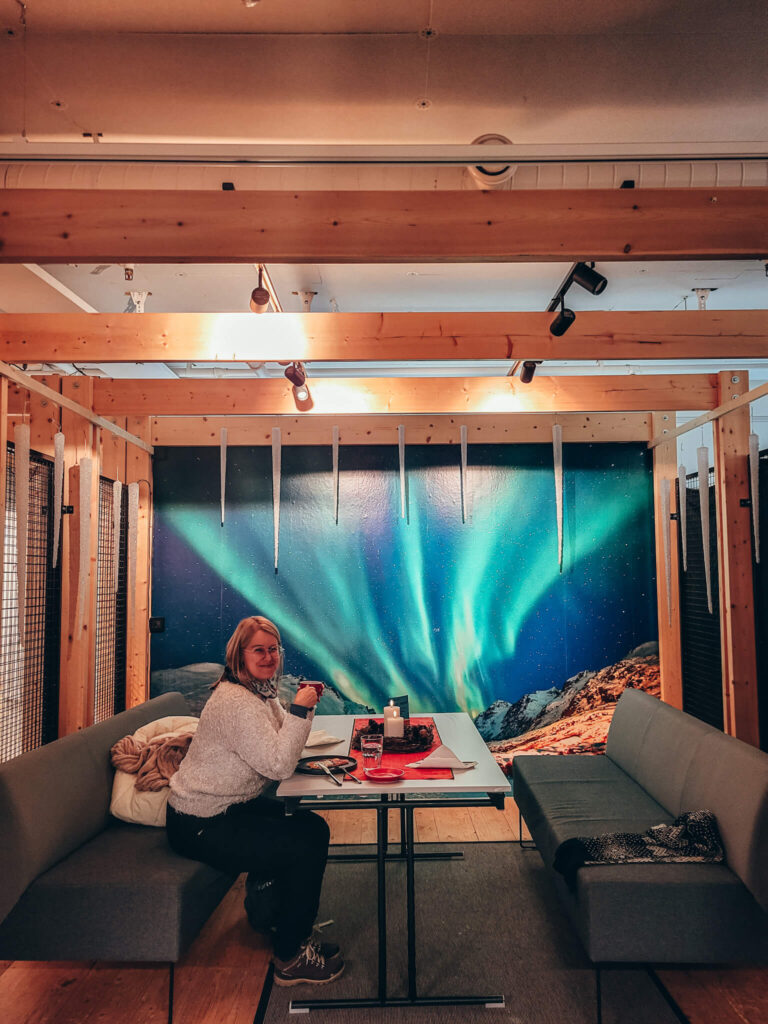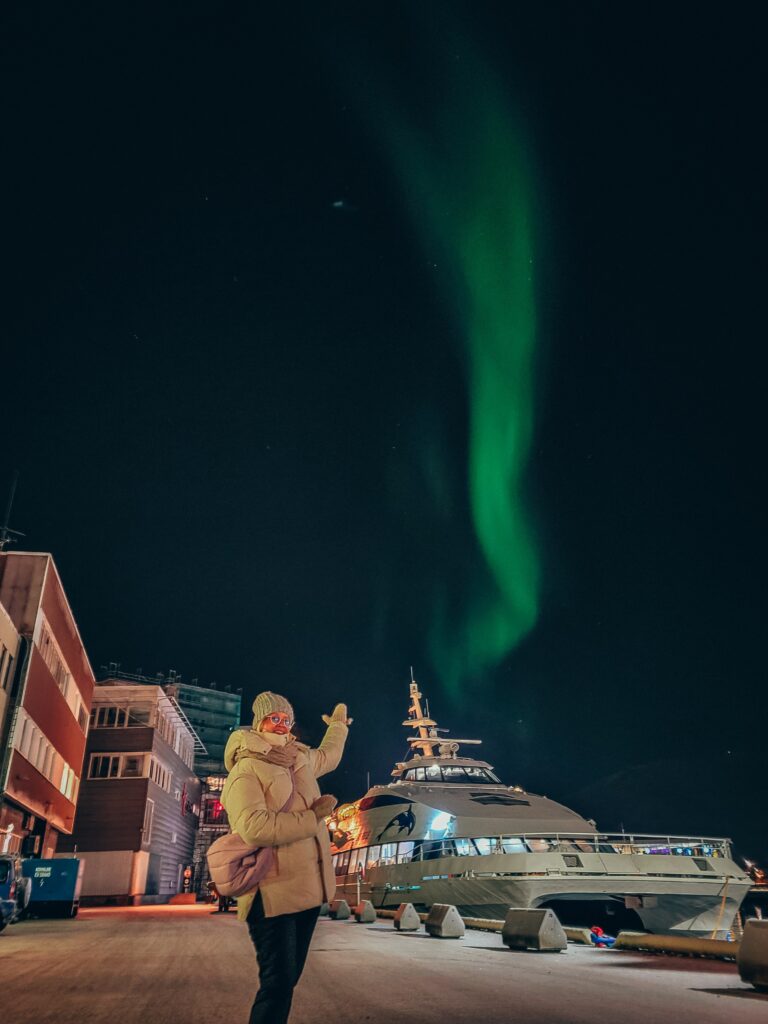
Where to see Northern Lights in Europe: Best Places
Some posts on this website contain affiliate links. I receive a small commission if you use the links at no extra cost to you.
The Northern Lights are one of the best views you can see during your trips. It was one of the best of mine. Absolutely magical. Where to see Northern Lights in Europe? What are the best places and best time to see them?
Seeing the Northern Lights is a dream for many people. In this article, I will tell you where you can see the Lights, when to see them, and how to organise your Northern Lights trip.
Northern Lights, what is this?
The Northern Lights, also called Aurora Borealis, are natural phenomenon created by solar activity. Solar storms send particles that are brought to Earth’s atmosphere by solar wind. And once they touch Earth’s atmosphere, they create a reaction. And the reaction is exactly what we see as the Northern Lights. That’s why it’s possible to forecast Aurora. As it takes time for solar winds to bring particles.
In forecasts, you will always find information regarding KP. KP is the index that describes activity. It ranges from 0 to 10, the higher it is, the stronger the display is, and more southerly Aurora is visible.
The Northern Lights have different shapes; they look like dancing waves or ribbons in the sky. Most often we can see green Lights. But there are also other colours. Colour and intensity depend on the level, height at which they appear and what gas is there. Green colours (and pink and red) appear if atmosphere is high in oxygen. Blue or violet if it’s mostly hydrogen and helium.
It’s a less-known fact that there are also the Southern Lights (Aurora Australis), which you can see in the southern hemisphere, for example, in New Zealand. They are created in the same way.
When to see Northern Lights in Europe?
The best time to see the Aurora in Europe is from late September to late March, sometimes early April.
Many people think that it’s best to see the Northern Lights during the winter months, like January or February. My extensive research last year before booking my Northern Lights trip showed something different. It’s a good time, but autumn months like October, or November, and March could be better. It all depends on solar activity and the weather. In January and February, statistically, a few Aurora places can be more cloudy.
December and January are also times of polar night. This is the time when the sun doesn’t really rise and it’s constantly grey-almost dark. This happens only within polar circles, so you can experience it in places that are beyond the Artic Circle, for example, Tromso in Norway.
It’s good timing to see the Northern Lights. But mentioning it, as maybe you would prefer to visit places and see them with a bit of daylight. During the Northern Lights season the day is short anyway.
How to see Northern Lights?
There are a few conditions that need to be met to be able to see the Aurora Borealis:
First of all, solar activity and solar wind to create Aurora.
Secondly, weather conditions: the sky should be clear and not very cloudy.
Thirdly, you need to be in the dark; there has to be a lack of light pollution. So the more remote location, the better. It’s not really easy to see Lights in a big city.
If you are chasing the Northern Lights, look towards the north.
And, take pictures. Why?
If the Aurora is strong, you can see it with the naked eye. But, with the camera, it’s usually visible better, and it’s more ‘green’. If you see the Northern Lights for the first time, you may have difficulties spotting them with the naked eye. If you take pictures, it will help you to notice them.
If Lights are strong, they are visible on your phone’s camera even without some special settings. Of course, there are some rules for how to capture them well, but it’s not my expertise, so I will skip this information.
What I can just add as advice is to use special apps that inform you about the Northern Lights forecast and send notifications if chances are high. Last year in Tromso, I used an app called Aurora, and it really worked well.
Sometimes, in hotels, they can inform you if Aurora appears. It’s a good option if you feel like resting that night but don’t want to miss the Lights.
How to increase your chances to see Aurora
If you want to increase your chances of being successful with the Northern Lights chase, go on a guided tour (here you can find more description of Northern Lights Tours). Obviously, agency and guide don’t have influence on activity and clouds. But they know the place well, the weather forecast, and the special spots. They will drive you and guide you as much as it is possible this particular night. If you chase alone, you will not know all these details. Many great organised Aurora-chasing trips are available here.
Where to see Northern Lights in Europe?
The Northern Lights, as the name indicates, can be seen in the northern hemisphere. You can see them, for example, in some parts of the USA and northern Canada. In this article, I focus on the best places in Europe. They are all in Northern Europe region.
Probably the most known are the ones in the Nordic countries. But there are a few more spots.
Let’s review them in more detail.
Best places to see Northern Lights in Europe: Northern Norway
Starting from Northern Norway, as it’s the place where my dream of seeing the Aurora Borealis came true. Places to look at are Alta, Bodo, Lofoten Islands, and Tromso.
To get to Lofoten, you will probably go via Bodo. You can arrive in Bodo (by plane or train) and take a ferry further north. From Bodo, you can also take the plane to the islands, as there are flights from Bodo to two airports on Lofoten: Leknes and Svolvaer.
You can also fly from Oslo to Narvik and drive from there.
Tromso
It’s probably easiest to get to Tromso, as there are direct flights from European cities: Frankfurt, Zurich, Helsinki, London, and Gdańsk in Poland. If these airports are not good for you, you can fly to Tromso via Oslo or any other Norwegian airport, like Bergen or Trondheim.
Tromso is an excellent place and has a great climate for chasing the Northern Lights. As it’s at the seaside, it’s milder and not as extremely cold as in other regions. And sometimes, you can see the Lights in Tromso even at KP 1.
It’s also a great place for a trip, regardless of Aurora. The views in the town itself and around it are incredible. In town, there are museums and places to visit, good hotel infrastructure, etc.
It’s also a place ready for tourists. There are many travel agencies that organise different activities (like dog sledding). And the one that is probably the most popular is chasing the Northern Lights. In small or large groups, with or without dinner, you can easily find the option that suits you the best. I would advise booking the trip before you go, as it’s quite popular and places can sell out.
The best is to look at Get Your Guide; you can find most of the agencies that start their trips in Tromso there. I visited Tromso in November 2022 and took this Aurora-chasing group tour. And it was simply great.



Where Santa Claus comes from: Finnish Lapland
Another great place to see the Northern Lights (but also just to spend amazing time and visit) is Finnish Lapland. It’s a big region with 5 airports, although probably the most known is Rovaniemi. This is where Santa Claus Village is.
To Rovaniemi, you can fly directly from a few German airports, with KML via Amsterdam, or with Ryanair and Easyjet from London and a few more UK airports. To Rovaniemi and other airports, you can fly easily via Helsinki.
You can also take the train from Helsinki; it will take you 10-12 hours, and it’s a train with sleeping cabins. Or even drive, but it’s really a long journey, around 14 hours.
Finnish Lapland is very high on my travel bucket list, and I’m hoping that soon, because of the increasing number of flights, I will visit it.
Somehow, seeing the Northern Lights is addictive. It doesn’t matter I’ve seen them. It’s not enough; I want more.
What’s absolutely catchy are the interesting and beautiful possibilities of accommodation. Cabins with a glass roof to enjoy the lights, or even ice hotels.
Here are a few (in whole region, not only Rovaniemi) that are not cheap but just look amazing: ArcticSnow Hotel&Glass Igloos, Lapland Hotels Sky Ounasvaara, Northern Lights Glass Igloo Gateway for Couples and Aurora Village Ivalo.
Similar to the Northern Norway part, this is not only a trip for the Northern Lights. There are many more activities that you can do (visit Santa Claus Village, learn about Sami culture, watch reindeers, etc). Book you spots here.
More information about Finnish Lapland can be found on the official Lapland website.
Where to see Northern Lights in Europe: Swedish Lapland
Lapland is mostly associated with Finland. However, parts of the Lapland region also spread in Norway, Russia, and Sweden. Swedish Lapland, in northern Sweden, is another great idea for a Northern Lights trip.
The most known places are: Abisko (archipelago and Abisko National Park), Kiruna, Lulea, and Skelleftea. The last three names are cities with airports, to which you can get from Stockholm Arlanda.
I remember there were international (from Poland) flights to Lulea, but I can’t find any at the moment. You can fly to Lulea from Paris (with Transavia) and with Eurowings to Kiruna from a few airports.
So, there are not many international options. Anyway, there are many flights from Stockholm and a few from Goteborg.
You can also reach the region by the train from Stockholm, Goteborg, and Malmo. Or by car. Actually, there are many interesting road trip options in the region, as described here.
When it comes to attractions, again, use Get Your Guide to check and book any trips.
And ideas for accommodations that seem special and from which you can see the Northern Lights are here: Icehotel, Northern Lights Camp and Northern Lodges.
Iceland
Another great and popular destination to see the Northern Lights in Europe is Iceland. And, if you look at the map, it’s quite logical why.
To get to Iceland, you need to take a ferry or a plane. A ferry goes weekly from Denmark via the Faroe Islands and the trip takes around 3 days. There is a high chance you will travel with the plane. There is one international airport in Iceland: Keflavik, which is around 50 km (31mi) from the capital, Reykjavik. There are many flights throughout the year, and additionally a few seasonal flights to Iceland. There are direct flights Europe and USA and Canada. For details, you can check WayAway , which is a search engine for flights.
Where is the best to see the Northern Lights in Iceland? Well, with good weather and activity, you can see them even in Reykjavik. There are also many Chasing Lights trips that start in the city. Of course, it’s always best to look at Aurora outside of city lights.
There are a few places in Iceland that are recommended as perfect places to watch the Lights: Vik village and the West Fjords.
Best places to see Northern Lights in Europe: North of Scotland
Actually, it’s possible also in the south of Scotland, although it’s a rather special moment than standard. But yes, it does happen that the Lights are visible even around Edinburgh.
However, when looking at the best places to see the Northern Lights, we should look at the north of Scotland. Highlands, northern islands (like the Isle of Skye), Orkney and Shetland Islands.
Geographically, these are good places to see the Aurora. However, Scotland is rather a cloudy place, so it may not be that easy to see the beautiful Aurora even if activity is strong.
I probably wouldn’t recommend Scotland as your first choice if it’s a typical Northern Lights-chasing trip for you, but remember about this option if you want to see Scotland anyway (and well, I can’t recommend it enough; I’m totally in love with the views in this country).
To get to the northern parts of Scotland, you should fly to Glasgow, Edinburgh, or Aberdeen and from there get a train, bus or even a flight (there are small airports on a few islands, in Wick or Inverness).
Faroe Islands
The Faroe Islands, looking at the map, are located ‘above Scotland’. Therefore, it is possible to see the Northern Lights here as well. However, similarly to the north of Scotland, the weather is very capricious and you can expect frequent cloudiness and strong winds. Therefore, the Faroe Islands are not a very recommended destination after the summer season, many places on the Islands also close at this time.
This is definitely not the first choice destination when it comes to the Northern Lights, but it is worth remembering this place, because it is extremely beautiful.
Where to see Northern Lights in Europe: Other countries in north of Europe
When the activity is strong, you can also see the Northern Lights in the southern parts of the Nordic countries. And in the Baltic countries, especially in Estonia.
In past years, there were a few days that the Aurora was visible on the south coast of the Baltic Sea, meaning on the Polish coast. And actually, not only on the coast, it was visible even in the south of Poland, which is really unique. But it was due to very strong activity; if I remember correctly, it was at KP 7.
Apparently, the solar activity is in cycles, and at the moment we are approaching this strong activity solar cycle. That can mean we will be able to see the Aurora more often, more south, and not only around the Arctic Circle.
Let’s see if it’s right. Just remember that to see the Northern Lights well, you also need good weather (a clear sky) and darkness. So it’s pretty tough to see it in and around cities.
To summarize, the Northern Lights are an amazing natural phenomenon. As it’s natural, you never have a guarantee that you will see it exactly on the dates that you travel. But chances are high if you go to places where the Northern Lights are common. It will be the night and the trip you will remember forever. Good luck with your Aurora chase!
As you can see, travelling in the autumn and winter months can have big pluses. Interested in more winter trips? Check here for the best places in Europe to travel to during the winter.
*Disclaimer: This is not a scientific article. It’s a travelling post to help travellers organise the trip to see this amazing phenomenon. Written based on knowledge collected from different sources before I travelled myself to see Aurora.




